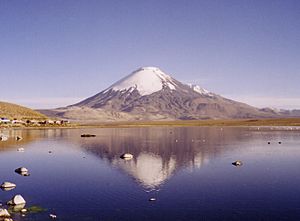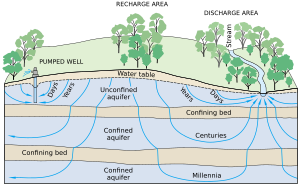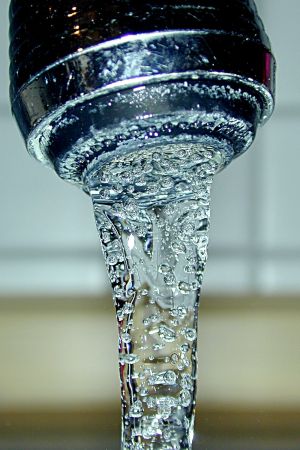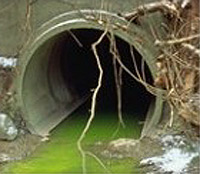Water resources facts for kids

Water resources are all the natural water on Earth that we can use. This includes water for drinking, growing food, and for factories. Most of Earth's water (97%) is salty, like the ocean. Only a small part (3%) is fresh water. Most of this fresh water is frozen in glaciers and polar ice caps. The rest is mostly underground (groundwater) or in rivers, lakes, and the air. We also get fresh water from treating used water or removing salt from ocean water. People use water for farming, industries, homes, fun activities, and to help nature.
Sometimes, there isn't enough water, or it gets polluted. This can lead to water conflicts. Fresh water can be renewed, but our underground water supplies are shrinking in many places. This is especially true in Asia, South America, and North America. It's important to manage water carefully so there's enough for everyone and for nature. The rules for how water is shared are called water rights.
Where Does Fresh Water Come From?
Fresh water comes from natural places like surface water (rivers, lakes), water flowing under rivers, groundwater (underground water), and frozen water (ice and glaciers).
Surface Water
Surface water is the water found in rivers, lakes, or fresh water wetlands. Rain and snow naturally refill surface water. Water is lost when it flows into the oceans, evaporates into the air, or soaks into the ground to become groundwater. The amount of water in a surface water system depends on many things. These include how much water lakes, wetlands, and human-made reservoirs can hold. It also depends on how easily water can soak into the soil and how quickly rain runs off the land.
People often build reservoirs to store more water. They might also drain wetlands, which reduces water storage. Paving areas and straightening rivers can make water run off faster.
We can also bring surface water from other areas using canals or pipelines.
Brazil has the most fresh water in the world, followed by Russia and Canada.
-
Panorama of a natural wetland (Sinclair Wetlands, New Zealand)
Water from Glaciers
Water that melts from glaciers is also considered surface water. The Himalayas, called "The Roof of the World," have huge areas of glaciers. Ten of Asia's biggest rivers start there, and over a billion people rely on them. Sadly, temperatures in the Himalayas are rising faster than the global average. This means glaciers are melting more quickly.
Groundwater
Groundwater is water found underground in the tiny spaces within soil and rocks. Imagine a sponge full of water – that's a bit like how water fills up the ground! When a rock layer or soil can hold a lot of water and let it flow, it's called an aquifer. The top level where the ground is completely filled with water is known as the water table.
Groundwater naturally gets refilled from rain and rivers. It also flows back to the surface in places like springs or wetlands. People often use groundwater for farming, for cities, and for factories by digging wells. Studying how groundwater moves and where it's found is called hydrogeology.Under River Flow
In many rivers, a lot of water flows not just on the surface, but also through the rocks and dirt under the river and its floodplain. This hidden flow is called the hyporheic zone. In some large valleys, this unseen water can be much more than the visible river flow. This zone acts as a link between surface water and underground water (aquifers). It's especially important in karst areas, where underground rivers are common.
Other Ways We Get Usable Water
We can also get fresh water from human-made sources. These include treating used water (reclaimed water), atmospheric water generators (machines that pull water from the air), and removing salt from ocean water. However, we need to think about the cost and environmental effects of these methods.
Reusing Wastewater
Reclaimed water (also called recycled water or water reclamation) is water that has been used before and then cleaned so it can be used again. This process turns wastewater (water that goes down drains from homes, schools, and businesses) into water that is safe for other uses.
People can use reclaimed water for many things. It can water gardens and farm fields (irrigation). It can also refill natural water sources like rivers, lakes, and underground water supplies (groundwater recharge). Sometimes, very clean reclaimed water can even be used in homes for things like flushing toilets. In some places, it's cleaned so much that it's safe to drink! This is called "potable reuse."Desalinated Water
Desalination is a special process that takes out extra salt and other minerals from water. This makes the water fresh and safe for animals to drink or for irrigation (watering crops).
Sometimes, when almost all the salt is removed for people to drink, the process can also create table salt as a side product.New Ways to Get Water
Catching Air Moisture Over Oceans
Scientists have suggested that we could get a lot more fresh water by "catching humid air" over the oceans. This could help with water shortages now and in the future.
Atmospheric Water Generators on Land
Studies suggest that portable, solar-powered machines that collect water from the air could help a billion people get safe drinking water. However, relying on these machines might sometimes make it harder to build permanent water pipes for communities.
How We Use Water
The total amount of water available at any time is very important. Some users need water only at certain times. For example, many farms need a lot of water in the spring but none in the winter. To supply these farms, a surface water system might need large storage areas to collect water all year and release it quickly. Other users, like power plants, need water all the time for cooling. For them, a surface water system just needs enough storage for when river flow is low. Over time, the average rainfall in an area sets the limit for how much natural surface water can be used.
Water for Farming and Irrigation
About 70% of the world's water is used for irrigation (watering crops). A lot of this water use is not sustainable. It takes about 2,000 to 3,000 liters of water to grow enough food for one person's daily needs. This is a huge amount compared to the 2 to 5 liters needed for drinking. To feed the over 7 billion people on Earth today, we need water that would fill a canal 10 meters deep, 100 meters wide, and 2100 kilometers long!
In 2007, a study looked at water use in farming. It found that one-fifth of the world's people (over 1.2 billion) live where there isn't enough water to meet all needs. Another 1.6 billion people live where there's enough water, but not enough money or skills to get it to everyone. The report said we can grow enough food in the future. But if we keep using water as we do now, many parts of the world will face water crises. To avoid this, farmers need to grow more food with less water. Industries and cities also need to use water more wisely.
In some places, irrigation is essential for growing any crops. In others, it helps grow more valuable crops or increases how much food is produced. Different irrigation methods use water differently. Some, like furrow and overhead sprinklers, are cheaper but waste more water through evaporation or runoff. More efficient methods include drip irrigation and some types of sprinklers that spray water closer to the ground. These are more expensive but waste less water. Any system can be wasteful if not managed well. It's also important to avoid making groundwater salty or polluting it.
As the world's population grows, we need more food. So, people are trying to find ways to produce more food with less water. This involves better irrigation, new technologies, smart agricultural water management, and choosing different types of crops. Aquaculture (farming fish and other water animals) is also a growing use of water.
Changing landscapes for farming greatly affects fresh water flow. Removing trees and changing soils changes how fresh water moves in the local area. This can lead to more fresh water being stored in the soil, which helps farming. However, since farming uses the most fresh water, it can put a lot of stress on local water supplies. This can even harm local ecosystems.
In Australia, taking too much fresh water for farming has put 33% of the land at risk of becoming salty (salination).
| Animal | Average per day | Range per day |
|---|---|---|
| Dairy cow | 76 L (20 US gal) | 57 to 95 L (15 to 25 US gal) |
| Cow-calf pair | 57 L (15 US gal) | 8 to 76 L (2 to 20 US gal) |
| Yearling cattle | 38 L (10 US gal) | 23 to 53 L (6 to 14 US gal) |
| Horse | 38 L (10 US gal) | 30 to 53 L (8 to 14 US gal) |
| Sheep | 8 L (2 US gal) | 8 to 11 L (2 to 3 US gal) |
| Crop | Water needs (mm / total growing period) |
|---|---|
| Sugar Cane | 1500–2500 |
| Banana | 1200–2200 |
| Citrus | 900–1200 |
| Potato | 500–700 |
| Tomato | 400–800 |
| Barley/Oats/Wheat | 450–650 |
| Cabbage | 350–500 |
| Onions | 350–550 |
| Pea | 350–500 |
Watering Green Spaces and Golf Courses
Urban green spaces and golf courses often need to be watered. Golf courses are sometimes criticized for using too much water, especially in dry areas. However, many golf courses use treated wastewater, which doesn't affect the supply of drinking water.
Water for Industries
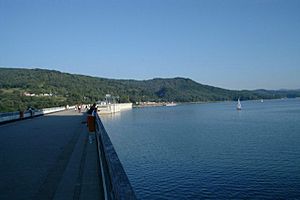
About 22% of the world's water is used in industry. Big industrial users include hydroelectric dams, power plants (which use water for cooling), and factories that use water in chemical processes or as a solvent. Industries can take out a lot of water, but they usually use up less than farming does.
Water is also used to make renewable power. Hydroelectric power uses the force of water flowing downhill to spin a turbine and create electricity. This is a cheap, clean, and renewable energy source. Hydroelectric power can also be turned on and off quickly, unlike some other renewable sources. The energy for hydroelectric power ultimately comes from the sun, which evaporates water that then falls as rain in high places and flows downhill. Some hydroelectric plants also pump water uphill when electricity demand is low, then release it to make power when demand is high.
Hydroelectric power plants usually need a large artificial lake. Water evaporates more from these lakes than from rivers because of the larger surface area, meaning more water is used up. Moving water through turbines also temporarily removes it from nature. The effect on wildlife depends on the power plant's design.
High-pressure water is used in water blasting and water jet cutters for precise cutting. This method is effective, safe, and good for the environment. Water is also used to cool machinery, like saw blades, to prevent overheating. This use of water is usually very small compared to other uses.
Water is also used in many big industrial processes, like making electricity, refining oil, making fertilizer, and getting gas from shale rock. When industries release untreated water, it causes pollution. This pollution can include chemicals or increased water temperature (thermal pollution). Industries need very pure water for many tasks and use different ways to clean water both when they take it in and when they release it. Most of this pure water is made on-site. Industries generally use up much less water than they take out. This is because laws often require them to treat used water and return it to the environment. However, power plants that use cooling towers use up almost all the water they take out, as most of it evaporates during cooling.
Drinking Water and Home Use
About 8% of the world's water is used in homes. This includes drinking water, bathing, cooking, flushing toilets, cleaning, laundry, and gardening. Experts say that a basic amount of water needed for home use is about 50 liters per person per day, not counting water for gardens.
Drinking water is water that is clean enough to drink or use without causing harm. In most developed countries, the water supplied to homes and businesses is clean enough to drink, even though only a small part of it is actually consumed.
In 2017, 844 million people still didn't have even basic drinking water services. Of those, 159 million people drank water directly from surface sources like lakes and streams.
One in eight people worldwide don't have access to safe water. Using water improperly can make this problem worse. The tables below show how much water is needed for basic human needs.
| Activity | Minimum (liters / day) | Range (liters / day) |
|---|---|---|
| Drinking Water | 5 | 2–5 |
| Sanitation Services | 20 | 20–75 |
| Bathing | 15 | 5–70 |
| Cooking and Kitchen | 10 | 10–50 |
Water for the Environment
Using water specifically for the environment is a small but growing part of total water use. This can include water released from dams to help nature, or water kept in rivers by rules that limit how much can be taken out. Environmental water use helps natural or artificial wetlands, creates wildlife habitats, helps fish move past dams (fish ladders), and releases water from reservoirs at certain times to help fish lay eggs or restore natural river flows.
Environmental water use doesn't use up the water, but it might mean less water is available for other users at certain times and places. For example, water released from a reservoir for fish might not be available for farms upstream.
Water for Fun (Recreation)
Recreational water use is mostly linked to lakes, dams, rivers, or oceans. If a water reservoir is kept fuller for fun activities, that extra water is considered recreational use. Examples include fishing, water skiing, enjoying nature, and swimming.
Recreational use usually doesn't use up the water. However, it might reduce water availability for other users at certain times. For instance, water kept in a reservoir for boating in late summer isn't available for farmers during spring planting. Water released for whitewater rafting might not be available for making electricity when it's most needed.
Challenges and Threats to Water
Water resources face threats like: not enough water (water scarcity), dirty water (water pollution), conflicts over water, and climate change.
Water Scarcity
Water Pollution
Water Conflict
Climate Change
Managing Water Resources
Water resource management is about planning, developing, sharing, and making the best use of water. It's part of managing the whole water cycle. Water managers need to keep adapting to new challenges, especially with climate change making things uncertain. They will likely face situations they've never seen before. Because of this, new ways of managing water, like involving more people and being flexible, are becoming more common.
Ideally, water management plans consider all the different demands for water and try to share it fairly. In reality, this is hard. So, decision-makers must prioritize keeping water supplies healthy for the future, sharing fairly, and using resources efficiently. One of the biggest concerns for water resources is making sure there's enough for current and future generations.
Sustainable Development Goal 6 includes a goal for water management: "Target 6.5: By 2030, implement integrated water resources management at all levels, including through transboundary cooperation as appropriate."
Sustainable Water Management
Right now, only about 0.08% of all the world's fresh water is easily available. And there's a growing demand for drinking, manufacturing, fun activities, and agriculture. Because so little fresh water is available, making the best use of what we have is a growing challenge worldwide.
A lot of effort in water management focuses on using water wisely and reducing its environmental impact on nature. Thinking of water as a key part of the ecosystem is the basis of integrated water resources management. This idea comes from the 1992 Dublin Statement.
Sustainable water management needs a complete approach based on the ideas of Integrated Water Resource Management (IWRM). These ideas were first shared at conferences in Dublin and Rio in 1992. The four Dublin Principles are:
- Fresh water is a limited and important resource, needed for life, development, and the environment.
- Water projects and management should involve everyone: users, planners, and policy-makers.
- Women play a key role in providing, managing, and protecting water.
- Water has an economic value in all its uses and should be seen as an economic good.
Since 1992, these principles have guided changes in water management laws around the world.
Another challenge for managing water sustainably and fairly is that many water bodies cross borders. These can be international borders (leading to water conflict) or borders within a country (like the Murray-Darling basin in Australia).
Integrated Water Resources Management (IWRM)
The Global Water Partnership (GWP) defines Integrated Water Resources Management (IWRM) as "a process which promotes the coordinated development and management of water, land and related resources, in order to maximize the resultant economic and social welfare in an equitable manner without compromising the sustainability of vital ecosystems".
Some experts say that IWRM helps achieve water security. Water security is the goal, and IWRM is the process to reach that goal.
IWRM became a popular idea at international conferences in the late 1900s and early 2000s. However, people have been managing water together for centuries. Discussions about managing water in a complete way started in the 1950s. The 1992 International Conference on Water and the Environment strongly recommended IWRM. This idea aims to change practices to improve water resource management. IWRM was a main topic at the second World Water Forum, which led to the creation of the GWP.
The International Water Association says IWRM has three main principles:
- Fairness for all: Making sure everyone, especially poor or marginalized groups, has enough good quality water for their well-being.
- Economic efficiency: Getting the most benefit for the most people from the available money and water.
- Environmental health: Recognizing that aquatic ecosystems also need water and making sure they get enough to stay healthy.
In 2002, IWRM was discussed at the World Summit on Sustainable Development in Johannesburg. The goal was to encourage IWRM worldwide. The third World Water Forum also recommended IWRM and talked about sharing information, involving different groups, and considering gender and social class.
How IWRM is put into practice depends on the situation. The challenge is to turn these ideas into real actions.
In practice, IWRM uses knowledge from different fields and ideas from various groups. This helps create fair, efficient, and sustainable solutions for water and development problems. IWRM is a complete, participatory planning tool for managing water resources. It balances social and economic needs while protecting ecosystems for the future. Also, to help achieve the Sustainable Development Goals (SDGs), IWRM is now looking at the "Nexus approach." This approach recognizes that "water, energy, and food are closely linked."
Water has many uses: for farming, healthy ecosystems, people, and livelihoods. This means we need coordinated action. So, IWRM involves different sectors and aims to be an open, flexible process. It brings all interested parties together to make balanced decisions about water challenges.
IWRM focuses on three main things to avoid managing water in a disconnected way:
- Supportive Environment: Having the right rules and conditions is key to protecting the rights of all involved (people, businesses, governments) and public resources like the environment.
- Role of Institutions: Developing strong organizations is vital for creating and carrying out IWRM plans. Problems often arise when responsibilities, power, and abilities don't match up.
- Management Tools: These are the methods and tools that help decision-makers choose wisely between different actions.
Some other important things to consider when using IWRM are:
- Political will and commitment
- Building capacity (skills and knowledge)
- Enough money and stable funding
- Monitoring and evaluating progress
IWRM should be seen as an ongoing process, not a one-time solution. It's a long-term journey that keeps improving. There isn't one perfect way to do it. The skill of IWRM is choosing and adapting the right mix of tools for each unique situation.
Managing Water in Cities
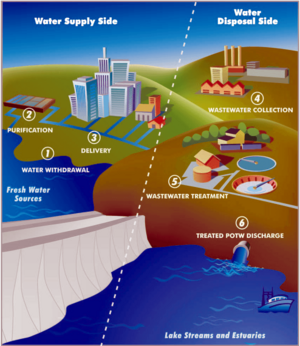
Water Resources Around the World
Water resource management and how water is governed differ from country to country. For example, in the United States, the United States Geological Survey (USGS) and its partners watch over water resources, do research, and inform the public about groundwater quality.
See Also
 In Spanish: Recurso hídrico para niños
In Spanish: Recurso hídrico para niños
- Holistic management
- International trade and water
- List of sovereign states by freshwater withdrawal
- List of countries by total renewable water resources
- Peak water
- Socio-hydrology
- Virtual water
- Water storage


